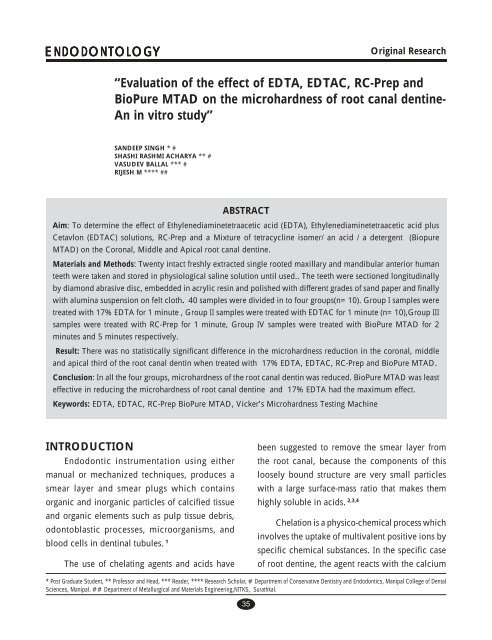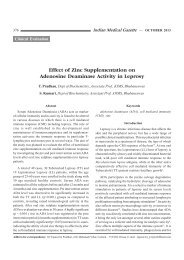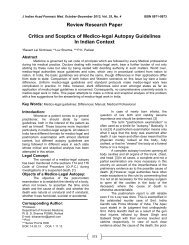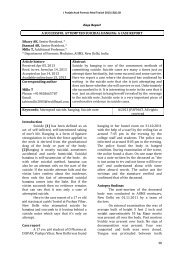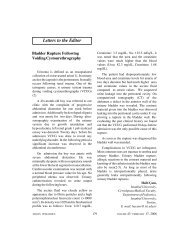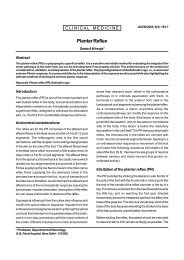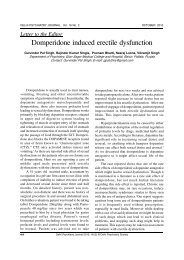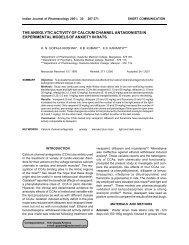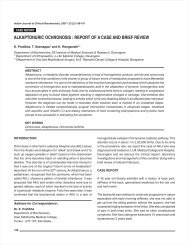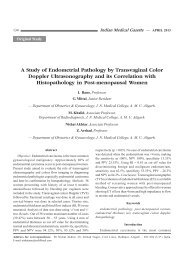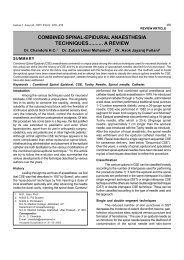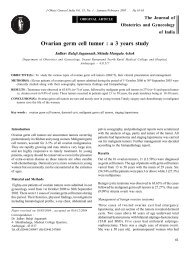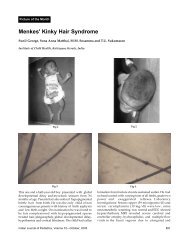Evaluation of the effect of EDTA, EDTAC, RC-Prep and BioPure ...
Evaluation of the effect of EDTA, EDTAC, RC-Prep and BioPure ...
Evaluation of the effect of EDTA, EDTAC, RC-Prep and BioPure ...
Create successful ePaper yourself
Turn your PDF publications into a flip-book with our unique Google optimized e-Paper software.
ENDODONTOLOGY<br />
ENDODONTOLOGY<br />
“<strong>Evaluation</strong> <strong>of</strong> <strong>the</strong> <strong>effect</strong> <strong>of</strong> <strong>EDTA</strong>, <strong>EDTA</strong>C, <strong>RC</strong>-<strong>Prep</strong> <strong>and</strong><br />
<strong>BioPure</strong> MTAD on <strong>the</strong> microhardness <strong>of</strong> root canal dentine-<br />
An in vitro study”<br />
SANDEEP SINGH * #<br />
SHASHI RASHMI ACHARYA ** #<br />
VASUDEV BALLAL *** #<br />
RIJESH M **** ##<br />
ABSTRACT<br />
Aim: To determine <strong>the</strong> <strong>effect</strong> <strong>of</strong> Ethylenediaminetetraacetic acid (<strong>EDTA</strong>), Ethylenediaminetetraacetic acid plus<br />
Cetavlon (<strong>EDTA</strong>C) solutions, <strong>RC</strong>-<strong>Prep</strong> <strong>and</strong> a Mixture <strong>of</strong> tetracycline isomer/ an acid / a detergent (Biopure<br />
MTAD) on <strong>the</strong> Coronal, Middle <strong>and</strong> Apical root canal dentine.<br />
Materials <strong>and</strong> Methods: Twenty intact freshly extracted single rooted maxillary <strong>and</strong> m<strong>and</strong>ibular anterior human<br />
teeth were taken <strong>and</strong> stored in physiological saline solution until used.. The teeth were sectioned longitudinally<br />
by diamond abrasive disc, embedded in acrylic resin <strong>and</strong> polished with different grades <strong>of</strong> s<strong>and</strong> paper <strong>and</strong> finally<br />
with alumina suspension on felt cloth. 40 samples were divided in to four groups(n=10). Group I samples were<br />
treated with 17% <strong>EDTA</strong> for 1 minute , Group II samples were treated with <strong>EDTA</strong>C for 1 minute (n=10),Group III<br />
samples were treated with <strong>RC</strong>-<strong>Prep</strong> for 1 minute, Group IV samples were treated with <strong>BioPure</strong> MTAD for 2<br />
minutes <strong>and</strong> 5 minutes respectively.<br />
Result: There was no statistically significant difference in <strong>the</strong> microhardness reduction in <strong>the</strong> coronal, middle<br />
<strong>and</strong> apical third <strong>of</strong> <strong>the</strong> root canal dentin when treated with 17% <strong>EDTA</strong>, <strong>EDTA</strong>C, <strong>RC</strong>-<strong>Prep</strong> <strong>and</strong> <strong>BioPure</strong> MTAD.<br />
Conclusion: In all <strong>the</strong> four groups, microhardness <strong>of</strong> <strong>the</strong> root canal dentin was reduced. <strong>BioPure</strong> MTAD was least<br />
<strong>effect</strong>ive in reducing <strong>the</strong> microhardness <strong>of</strong> root canal dentine <strong>and</strong> 17% <strong>EDTA</strong> had <strong>the</strong> maximum <strong>effect</strong>.<br />
Keywords: <strong>EDTA</strong>, <strong>EDTA</strong>C, <strong>RC</strong>-<strong>Prep</strong> <strong>BioPure</strong> MTAD, Vicker’s Microhardness Testing Machine<br />
INTRODUCTION<br />
Endodontic instrumentation using ei<strong>the</strong>r<br />
manual or mechanized techniques, produces a<br />
smear layer <strong>and</strong> smear plugs which contains<br />
organic <strong>and</strong> inorganic particles <strong>of</strong> calcified tissue<br />
<strong>and</strong> organic elements such as pulp tissue debris,<br />
odontoblastic processes, microorganisms, <strong>and</strong><br />
blood cells in dentinal tubules. 1<br />
The use <strong>of</strong> chelating agents <strong>and</strong> acids have<br />
* Post Graduate Student, ** Pr<strong>of</strong>essor <strong>and</strong> Head, *** Reader, **** Research Scholar, # Department <strong>of</strong> Conservative Dentistry <strong>and</strong> Endodontics, Manipal College <strong>of</strong> Dental<br />
Sciences, Manipal. ## Department <strong>of</strong> Metallurgical <strong>and</strong> Materials Engineering,NITKS, Surathkal.<br />
35<br />
Original Research<br />
been suggested to remove <strong>the</strong> smear layer from<br />
<strong>the</strong> root canal, because <strong>the</strong> components <strong>of</strong> this<br />
loosely bound structure are very small particles<br />
with a large surface-mass ratio that makes <strong>the</strong>m<br />
highly soluble in acids. 2,3,4<br />
Chelation is a physico-chemical process which<br />
involves <strong>the</strong> uptake <strong>of</strong> multivalent positive ions by<br />
specific chemical substances. In <strong>the</strong> specific case<br />
<strong>of</strong> root dentine, <strong>the</strong> agent reacts with <strong>the</strong> calcium
ENDODONTOLOGY<br />
ENDODONTOLOGY<br />
ions in <strong>the</strong> hydroxyapatite crystals. This process can<br />
cause changes in <strong>the</strong> microstructure <strong>of</strong> <strong>the</strong> dentine<br />
<strong>and</strong> changes in <strong>the</strong> Ca : P ratio.<br />
Various irrigating solutions have been tried,<br />
among which 17% <strong>EDTA</strong> has been popular as <strong>the</strong><br />
most <strong>effect</strong>ive chelating agent for <strong>the</strong> removal <strong>of</strong><br />
smear layer.<br />
Initially, <strong>the</strong> use <strong>of</strong> <strong>EDTA</strong> solution in<br />
Endodontics was proposed by Østby (1957) who<br />
recommended <strong>the</strong> use <strong>of</strong> 15% <strong>EDTA</strong> to assist with<br />
<strong>the</strong> instrumentation <strong>of</strong> calcified, narrow or blocked<br />
canals, because <strong>of</strong> its ability to foster <strong>the</strong> chelation<br />
<strong>of</strong> <strong>the</strong> calcium ions at a pH close to neutral (Hill<br />
1959).<br />
Hill <strong>and</strong> Goldberg <strong>and</strong> Abramovich reported<br />
that addition <strong>of</strong> a quaternary ammonium bromide<br />
(Cetavlon) to 15% <strong>EDTA</strong> increased <strong>the</strong> action by<br />
reducing its surface tension, because <strong>EDTA</strong><br />
solutions act only through direct contact with <strong>the</strong><br />
substrate. Guerisoli et al5 stated that <strong>the</strong> association<br />
<strong>of</strong> <strong>EDTA</strong> with a wetting agent enhances its<br />
bactericidal <strong>effect</strong>iveness.<br />
<strong>RC</strong>-<strong>Prep</strong> introduced by Stewart et al. in 1969,<br />
contains 15% <strong>EDTA</strong>, 10% urea peroxide (UP), <strong>and</strong><br />
glycol. Oxygen is set free by <strong>the</strong> reaction <strong>of</strong> <strong>RC</strong>-<br />
<strong>Prep</strong> with NaOCl irrigant so that pulpal remnants<br />
<strong>and</strong> blood coagulates can be easily removed from<br />
<strong>the</strong> root canal wall.<br />
<strong>BioPure</strong> MTAD a new irrigant, based on a<br />
mixture <strong>of</strong> antibiotic [ Doxycylcline Hyclate:-<br />
150mg/5ml (3%), citric acid (4.25%), <strong>and</strong> a<br />
detergent ( 0.5 % Polysorbate 80 detergent or<br />
Tween 80) ]. It has a pH <strong>of</strong> 2.15 that is capable <strong>of</strong><br />
removing inorganic substances. The recommended<br />
final irrigation to be done by <strong>BioPure</strong> MTAD is 5<br />
36<br />
minutes. It has also been confirmed that <strong>the</strong> smear<br />
layer removing capability <strong>of</strong> <strong>BioPure</strong> MTAD is not<br />
compromised when used for 2 minutes as final<br />
irrigant. 6<br />
It has been reported that some chemicals used<br />
for endodontic irrigation are capable <strong>of</strong> causing<br />
alterations in <strong>the</strong> chemical composition <strong>of</strong> dentin.<br />
7,8,9<br />
SANDEEP SINGH, SHASHI RASHMI ACHARYA, VASUDEV BALLAL, RIJESH M<br />
Any change in <strong>the</strong> Ca/P ratio may alter <strong>the</strong><br />
original proportion <strong>of</strong> organic <strong>and</strong> inorganic<br />
components, which in turn change <strong>the</strong><br />
microhardness, permeability, <strong>and</strong> solubility<br />
characteristics <strong>of</strong> dentin. 8,9,18,19<br />
Panighi <strong>and</strong> G’Sell10 reported a positive<br />
correlation between hardness <strong>and</strong> <strong>the</strong> mineral<br />
content <strong>of</strong> <strong>the</strong> tooth. It has been indicated that<br />
microhardness determination can provide indirect<br />
evidence <strong>of</strong> mineral loss or gain in dental hard<br />
tissues. 11 So as microhardness <strong>of</strong> root canal dentin<br />
is sensitive to its composition <strong>and</strong> surface changes,<br />
<strong>the</strong> present study aims to demonstrate that<br />
microhardness tests, being a simple <strong>and</strong> <strong>effect</strong>ive<br />
method to evaluate <strong>and</strong> compare <strong>the</strong><br />
demineralization power <strong>of</strong> different chelating<br />
agents , given that <strong>the</strong> tests are carefully calibrated.<br />
Thus <strong>the</strong> purpose <strong>of</strong> this study is to determine<br />
<strong>the</strong> <strong>effect</strong> <strong>of</strong> <strong>EDTA</strong>, <strong>EDTA</strong>C, <strong>RC</strong>-<strong>Prep</strong> <strong>and</strong> <strong>BioPure</strong><br />
MTAD solutions on <strong>the</strong> microhardness <strong>of</strong> human<br />
root canal dentine.<br />
MATERIALS AND METHODS<br />
Twenty intact freshly extracted single rooted<br />
maxillary <strong>and</strong> m<strong>and</strong>ibular anterior human teeth<br />
were taken <strong>and</strong> stored in physiological saline<br />
solution containing 0.1% Sodium azide until use.<br />
They were sectioned transversely at CEJ by
ENDODONTOLOGY<br />
ENDODONTOLOGY<br />
diamond disc <strong>and</strong> crowns were discarded.<br />
The teeth were sectioned longitudinally <strong>and</strong><br />
embedded in acrylic resin followed by polishing<br />
with different grades <strong>of</strong> s<strong>and</strong> paper <strong>and</strong> finally with<br />
alumina suspension on felt cloth. The samples were<br />
r<strong>and</strong>omly divided in to 4 groups (n=10) based on<br />
<strong>the</strong> test solution used.<br />
Group I: 17% <strong>EDTA</strong> solution was freshly<br />
prepared by using <strong>EDTA</strong> solution (pH=7.3) with<br />
<strong>the</strong> following composition:<br />
Disodium salt <strong>of</strong> <strong>EDTA</strong> (17.00g)<br />
Aqua dest. (100.00ml)<br />
5M Sodium hydroxide (9.25mL)<br />
Group II: <strong>EDTA</strong>C was freshly prepared by<br />
using 15% <strong>EDTA</strong> at (pH=7.3).<br />
0.75g <strong>of</strong> <strong>the</strong> detergent Cetyl-tri-methyl<br />
ammonium bromide is added to 100 ml <strong>of</strong> <strong>the</strong><br />
solution . 12<br />
Group III: <strong>RC</strong>-<strong>Prep</strong> ( Premier Dental<br />
Philadelphia, PA, USA), paste type chelator.<br />
Group IV: <strong>BioPure</strong> MTAD Tulsa Dental, USA<br />
Samples in Group I,II, III were treated with<br />
<strong>the</strong> chelating agent for 1 minute <strong>and</strong> in Group IV<br />
samples were treated for 2 <strong>and</strong> 5 minutes<br />
respectively.<br />
The subjected samples were treated with 1ml<br />
<strong>of</strong> specific solutions <strong>and</strong> were irrigated with 0.9%<br />
saline after <strong>the</strong>ir prescribed time limit. Since <strong>RC</strong>-<br />
<strong>Prep</strong> is a paste type chelator, it was coated on to<br />
<strong>the</strong> dentin surface by a F1 Protaper File.<br />
A MicroVicker’s Hardness Tester (Fuel<br />
37<br />
Instruments <strong>and</strong> Engineers Pvt. Ltd.) was used. The<br />
diamond-shaped indentations were carefully<br />
observed in an optical microscope with a digital<br />
camera <strong>and</strong> image analysis s<strong>of</strong>tware, allowing <strong>the</strong><br />
accurate digital measurement <strong>of</strong> <strong>the</strong>ir diagonals.<br />
The average length <strong>of</strong> <strong>the</strong> two diagonals was used<br />
to calculate <strong>the</strong> microhardness value (MHV). All<br />
experiments were completed under <strong>the</strong> same<br />
conditions: 50 g load <strong>and</strong> 15 s dwell time13 ,<br />
following <strong>the</strong> suggestions by Cruz-Filho et al.<br />
(2001) 14 . In each sample, three indentations were<br />
made each in <strong>the</strong> coronal, middle <strong>and</strong> apical third<br />
<strong>of</strong> <strong>the</strong> root canal dentin sample.<br />
At <strong>the</strong> beginning <strong>of</strong> <strong>the</strong> experiment, reference<br />
microhardness values (MHVs) were obtained for<br />
samples prior to application <strong>of</strong> <strong>the</strong> solutions (Before<br />
Application), so that <strong>the</strong> same samples can act as<br />
<strong>the</strong>ir own controls. In Group IV, after obtaining<br />
reference MHVs(Before Application), samples were<br />
subjected to <strong>the</strong> test solution for 2 minutes [After<br />
Application (2 min)] followed by additional 3<br />
minutes i.e. a total time exposure <strong>of</strong> 5 minutes [After<br />
Application (5 min)] a second <strong>and</strong> a third set <strong>of</strong><br />
measurements, adjacent to <strong>the</strong> previous ones, were<br />
obtained respectively.<br />
STATISTICAL ANALYSIS<br />
Statistical analysis for comparing<br />
microhardness values in <strong>the</strong> coronal, middle <strong>and</strong><br />
apical area <strong>of</strong> <strong>the</strong> root canal dentin for <strong>the</strong> four<br />
different test groups were carried out using 2-way<br />
ANOVA with repeated measures (P
ENDODONTOLOGY<br />
ENDODONTOLOGY<br />
reduced in <strong>the</strong> coronal, middle <strong>and</strong> apical third <strong>of</strong><br />
<strong>the</strong> root canal dentin. <strong>BioPure</strong> MTAD was least<br />
<strong>effect</strong>ive in reducing <strong>the</strong> microhardness <strong>of</strong> root<br />
canal dentine <strong>and</strong> 17% <strong>EDTA</strong> had <strong>the</strong> maximum<br />
<strong>effect</strong>.<br />
Intergroup Comparison<br />
Repeated Measures Anova Test (Table 1)<br />
38<br />
SANDEEP SINGH, SHASHI RASHMI ACHARYA, VASUDEV BALLAL, RIJESH M<br />
There was no statistically significant difference<br />
in <strong>the</strong> microhardness reduction in <strong>the</strong> coronal,<br />
middle <strong>and</strong> apical third <strong>of</strong> <strong>the</strong> root canal dentin<br />
when treated with 17% <strong>EDTA</strong>, <strong>EDTA</strong>C, <strong>RC</strong>-<strong>Prep</strong><br />
<strong>and</strong> <strong>BioPure</strong> MTAD.<br />
<strong>EDTA</strong> Microhardness Mean Std. Deviation N<br />
Before Application mean <strong>of</strong> Coronal 1/3rd 50.9600 8.03375 10<br />
Before Application mean <strong>of</strong> Middle 1/3rd 52.6067 8.09037 10<br />
Before Application mean <strong>of</strong> Apical 1/3rd 56.4200 13.07606 10<br />
After Application (1 min )mean <strong>of</strong> Coronal 1/3rd 46.1933 7.79013 10<br />
After Application (1 min ) mean <strong>of</strong> Middle 1/3rd 48.0333 7.86653 10<br />
After Application (1 min ) mean <strong>of</strong> Apical 1/3rd 51.6533 13.17985 10<br />
<strong>EDTA</strong>C MicrohardnessMean Std. Deviation N<br />
Before Application mean <strong>of</strong> Coronal 1/3rd 51.5867 3.50211 10<br />
Before Application mean <strong>of</strong> Middle 1/3rd 54.7633 2.12327 10<br />
Before Application mean <strong>of</strong> Apical 1/3rd 58.8900 1.63655 10<br />
After Application (1 min )mean <strong>of</strong> Coronal 1/3rd 47.7233 3.73264 10<br />
After Application (1 min ) mean <strong>of</strong> Middle 1/3rd 51.0800 2.19760 10<br />
After Application (1 min ) mean <strong>of</strong> Apical 1/3rd 54.6833 1.79631 10<br />
<strong>RC</strong>-<strong>Prep</strong> Microhardness Mean Std. Deviation N<br />
Before Application mean <strong>of</strong> Coronal 1/3rd 50.9000 6.51445 10<br />
Before Application mean <strong>of</strong> Middle 1/3rd 59.6733 5.08636 10<br />
Before Application mean <strong>of</strong> Apical 1/3rd 66.2400 3.91174 10<br />
After Application (1 min )mean <strong>of</strong> Coronal 1/3rd 46.9533 6.56081 10<br />
After Application (1 min ) mean <strong>of</strong> Middle 1/3rd 55.1133 5.15182 10<br />
After Application (1 min ) mean <strong>of</strong> Apical 1/3rd 62.3200 3.70176 10<br />
Bio-Pure - MTAD Microhardness Mean Std. Deviation N<br />
Before Application mean <strong>of</strong> Coronal 1/3rd 50.9500 8.00301 10<br />
Before Application mean <strong>of</strong> Middle 1/3rd 52.5567 8.07983 10<br />
Before Application mean <strong>of</strong> Apical 1/3rd 56.3267 12.96247 10<br />
After Application (2 min )mean <strong>of</strong> Coronal 1/3rd 49.8567 8.13277 10<br />
After Application (2 min ) mean <strong>of</strong> Middle 1/3rd 51.5067 8.28553 10<br />
After Application (2 min ) mean <strong>of</strong> Apical 1/3rd 54.9367 12.97142 10<br />
After Application (5 min )mean <strong>of</strong> Coronal 1/3rd 47.7967 8.12412 10<br />
After Application (5 min ) mean <strong>of</strong> Middle 1/3rd 49.5800 8.34076 10<br />
After Application (5 min ) mean <strong>of</strong> Apical 1/3rd 52.8300 12.98556 10
ENDODONTOLOGY<br />
ENDODONTOLOGY<br />
Befor Application Microhardness<br />
Comparison<br />
In <strong>the</strong> 40 samples tested, comparison <strong>of</strong> <strong>the</strong> microhardness <strong>of</strong> <strong>the</strong><br />
root canal dentin in coronal1/3 rd , middle1/3 rd <strong>and</strong> apical 1/3 rd<br />
respectively was statistically insignificant.<br />
Afteer Application Microhardness<br />
Comparison<br />
In <strong>the</strong> 40 samples tested, comparison <strong>of</strong> <strong>the</strong> microhardness reduction<br />
<strong>of</strong> <strong>the</strong> root canal dentin by different chemicals in coronal1/3 rd ,<br />
middle1/3 rd <strong>and</strong> apical 1/3 rd respectively was statistically<br />
insignificant.<br />
DISCUSSION<br />
Smear layer is a negative factor when sealing<br />
<strong>the</strong> root canal because <strong>of</strong> its weak adherence to<br />
<strong>the</strong> root canal walls hindering sealer adhesion.<br />
Thus, <strong>the</strong> removal before obturation to allow<br />
intimate contact <strong>of</strong> <strong>the</strong> sealer with <strong>the</strong> dentin surface<br />
is m<strong>and</strong>atory. 15<br />
Serper et al 16 , concluded in <strong>the</strong>ir study that<br />
17% <strong>EDTA</strong> has <strong>the</strong> potential for causing excessive<br />
peritubular <strong>and</strong> intertubular dentinal erosion if <strong>the</strong><br />
application time exceeds 1 min. Thus in <strong>the</strong> present<br />
study, all <strong>EDTA</strong> based chelating agents had<br />
application time which was limited to 1 minute.<br />
The irrigation regimen for <strong>BioPure</strong> MTAD is<br />
39<br />
“EVALUATION OF THE EFFECT OF <strong>EDTA</strong>, <strong>EDTA</strong>C, <strong>RC</strong>-PREP AND BIOPURE MTAD ON<br />
THE MICROHARDNESS OF ROOT CANAL DENTINE- AN IN VITRO STUDY”<br />
initial rinse with 1.3% Sodium hypochlorite during<br />
instrumentation <strong>and</strong> 5 minute final rinse with<br />
<strong>BioPure</strong> MTAD for <strong>effect</strong>ive removal <strong>of</strong> smear layer<br />
<strong>and</strong> desired antibacterial <strong>effect</strong>. A recent study<br />
showed that <strong>the</strong> use <strong>of</strong> a 2 minute final irrigation<br />
time did not compromise <strong>the</strong> smear layer removal<br />
capability <strong>of</strong> <strong>BioPure</strong> MTAD. 6 Thus, in <strong>the</strong> present<br />
study, we used both <strong>the</strong> time periods i.e. 2 <strong>and</strong> 5<br />
minutes for <strong>the</strong> application <strong>of</strong> <strong>BioPure</strong> MTAD <strong>and</strong><br />
consequently checked <strong>the</strong> microhardness.<br />
It is clear that <strong>the</strong> comparison between <strong>the</strong><br />
MHV values would be biased by <strong>the</strong> underlying<br />
differences in dentine morphology. Thus, in <strong>the</strong><br />
present work, <strong>the</strong> actual measurements were<br />
obtained from three indentations each in <strong>the</strong><br />
coronal, middle <strong>and</strong> apical third <strong>of</strong> root canal<br />
dentin. This methodological approach differs from<br />
<strong>the</strong> clinical situation in which <strong>the</strong> chelator<br />
substances affect <strong>the</strong> dentine walls more strongly.<br />
However, this approach allows a much better<br />
control <strong>of</strong> experimental variables, leading to readily<br />
comparable results that are fundamental for <strong>the</strong><br />
present study. 4<br />
It was also noted in all <strong>the</strong> samples that <strong>the</strong>ir<br />
was a variable increase in <strong>the</strong> microhardness from<br />
coronal to apical third <strong>of</strong> root canal dentin<br />
irrespective <strong>of</strong> treatment with any test agent. This<br />
may be attributed to <strong>the</strong> histology <strong>of</strong> <strong>the</strong> root canal<br />
dentin. Carrigan et al. 20 showed that tubule density<br />
decreased from cervical to apical dentine <strong>and</strong><br />
Pashley et al. 21 reported an inverse correlation<br />
between dentine microhardness <strong>and</strong> tubular<br />
density.<br />
In <strong>the</strong> present study, maximum decrease in<br />
microhardness was achieved by <strong>EDTA</strong> followed<br />
by <strong>RC</strong>-<strong>Prep</strong>, <strong>EDTA</strong>C <strong>and</strong> MTAD. But, <strong>the</strong> difference
ENDODONTOLOGY<br />
ENDODONTOLOGY<br />
in microhardness was statistically insignificant.<br />
Zehnder et al. 22 (2005) reported that <strong>the</strong><br />
association <strong>of</strong> an endodontic chelator solution with<br />
a wetting agent that reduces surface tension did<br />
not improve <strong>the</strong> <strong>effect</strong>iveness <strong>of</strong> Calcium ion<br />
removal. This conclusion is confirmed by <strong>the</strong><br />
present work, as <strong>EDTA</strong>C was not more <strong>effect</strong>ive<br />
than 17% <strong>EDTA</strong> in reducing <strong>the</strong> microhardness.<br />
In our study, <strong>BioPure</strong> MTAD treatment <strong>of</strong> root<br />
canal dentin resulted in least microhardness<br />
reduction <strong>of</strong> root canal dentin. This finding is in<br />
agreement with past study which reported that<br />
<strong>BioPure</strong> MTAD is <strong>effect</strong>ive in removing smear layer<br />
<strong>and</strong> at <strong>the</strong> same time is milder on <strong>the</strong> dentin<br />
structure. 17<br />
However, Gustavo et al 23 reported that <strong>the</strong>re<br />
is full saturation <strong>of</strong> <strong>the</strong> demineralizing ability <strong>of</strong><br />
<strong>BioPure</strong> MTAD after 30 seconds. In <strong>the</strong> present<br />
study, <strong>the</strong>re was reduction in microhardness <strong>of</strong> root<br />
canal dentin after 2 minutes <strong>of</strong> treatment with<br />
<strong>BioPure</strong> MTAD <strong>and</strong> <strong>the</strong>re was fur<strong>the</strong>r decrease in<br />
microhardness after a total <strong>of</strong> 5 minutes <strong>of</strong><br />
application. This implies that <strong>BioPure</strong> MTAD has<br />
demineralizing ability beyond 2 minutes <strong>and</strong> up<br />
to 5 minutes.<br />
On <strong>the</strong> basis <strong>of</strong> <strong>the</strong> results obtained <strong>and</strong><br />
experimental conditions <strong>of</strong> <strong>the</strong> present study we<br />
can conclude that..<br />
1. There was no statistically significant<br />
difference in <strong>the</strong> microhardness reduction <strong>of</strong> <strong>the</strong><br />
root canal dentin by 17% <strong>EDTA</strong>, <strong>EDTA</strong>C, <strong>RC</strong>-<strong>Prep</strong><br />
<strong>and</strong> <strong>BioPure</strong> MTAD.<br />
2. Overall, <strong>BioPure</strong> MTAD was least <strong>effect</strong>ive<br />
in reducing <strong>the</strong> microhardness <strong>of</strong> <strong>the</strong> root canal<br />
40<br />
SANDEEP SINGH, SHASHI RASHMI ACHARYA, VASUDEV BALLAL, RIJESH M<br />
dentine <strong>and</strong> 17% <strong>EDTA</strong> had <strong>the</strong> maximum <strong>effect</strong>.<br />
REFERENCES<br />
1. Sen BH, Wesselink PR, Turkun M. The smear layer: a<br />
phenomenon in root canal <strong>the</strong>rapy. International Endodontic<br />
Journal 1995;28:141– 8.<br />
2. Pashley DH. Smear layer: overview <strong>of</strong> structure <strong>and</strong><br />
function. Proc Finn Dent Soc 1992;88(Suppl l):215-24.<br />
3. Torabinejad M, H<strong>and</strong>ysides R, Khademi AA, Bakl<strong>and</strong> LK.<br />
Clinical implications <strong>of</strong> <strong>the</strong> smear layer in endodontics: a<br />
review. Oral Surg Oral Med Oral Pathol Oral Radiol Endod<br />
2002;94:658-66.<br />
4. De-Deus G, Paciornik S, Mauricio MH. <strong>Evaluation</strong> <strong>of</strong> <strong>the</strong><br />
<strong>effect</strong> <strong>of</strong> <strong>EDTA</strong>, <strong>EDTA</strong>C <strong>and</strong> citric acid on <strong>the</strong> microhardness<br />
<strong>of</strong> root dentine. International Endodontics Journal<br />
2006;39:401-7.<br />
5. Guerisoli DM, Marchesan MA, Walmsley AD, Lumley PJ,<br />
Pecora JD. <strong>Evaluation</strong> <strong>of</strong> smear layer removal by <strong>EDTA</strong>C <strong>and</strong><br />
sodium hypochlorite with ultrasonic agitation. International<br />
Endodontic Journal. 2002 May;35(5):418-21.<br />
6. Torabinejad M, Cho Y, Khademi AA, Bakl<strong>and</strong> LK,<br />
Shabahang S. The <strong>effect</strong> <strong>of</strong> various concentrations <strong>of</strong> sodium<br />
hypochlorite on <strong>the</strong> ability <strong>of</strong> <strong>BioPure</strong> MTAD to remove <strong>the</strong><br />
smear layer. Journal <strong>of</strong> Endodontics 2003;29:233–9.<br />
7. Dogan H, Calt S. Effects <strong>of</strong> chelating agents <strong>and</strong> sodium<br />
hypochlorite on mineral content <strong>of</strong> root dentin. Journal <strong>of</strong><br />
Endodontics 2001;27:578-80.<br />
8. Rotstein I, Dankner E, Goldman A, Heling I, Stabholz A,<br />
Zalkind M. Histochemical analysis <strong>of</strong> dental hard tissues<br />
following bleaching. Journal <strong>of</strong> Endodontics 1996;22:23-5.<br />
9. Ari H, Erdemir A. Effects <strong>of</strong> endodontic irrigation solutions<br />
on mineral content <strong>of</strong> root canal dentin using ICP-AES<br />
technique. Journal <strong>of</strong> Endodontics 2005;31:187-9.<br />
10. Panighi M, G Sell C. Effect <strong>of</strong> <strong>the</strong> tooth microstructure on<br />
<strong>the</strong> shear bond strength <strong>of</strong> a dental composite. J Biomed Mater<br />
Res 1993;27:975-81.<br />
11. Rotstein I (1994) Effect <strong>of</strong> hydrogen peroxide <strong>and</strong> sodium<br />
perborate on <strong>the</strong> microhardness <strong>of</strong> human enamel <strong>and</strong><br />
dentine. Journal <strong>of</strong> Endodontics 20, 61–3.<br />
12. Pawlicka H (1982) Verwendung der Chelatverbindungen<br />
zur Erweiterung der Wurzelkanale: Mikroharteuntersuchung.<br />
Stomatologie der DDR 3,355-61.<br />
13. Antonio M, Manoel D. <strong>Evaluation</strong> <strong>effect</strong> <strong>of</strong> <strong>EDTA</strong>, CDTA<br />
<strong>and</strong> EGTA on Radicular Dentin Microhardness. Journal <strong>of</strong><br />
Endodontics 2001; 27;3; 183-184.<br />
14. Cruz-Filho AM, Sousa-Neto MD, Saquy PC, Pecora JD<br />
(2001) <strong>Evaluation</strong> <strong>of</strong> <strong>the</strong> <strong>effect</strong> <strong>of</strong> <strong>EDTA</strong>C, CDTA <strong>and</strong> EGTA
ENDODONTOLOGY<br />
ENDODONTOLOGY<br />
on radicular dentine microhardness. Journal <strong>of</strong> Endodontics<br />
27,183–4.<br />
15. Sousa Neto MD, Marchesan MA, Pécora JD, Brugnera<br />
Junior A, Sousa YTCS, Saquy PC. Effect <strong>of</strong> Er:YAG laser on<br />
adhesion <strong>of</strong> root canal sealer. Journal <strong>of</strong> Endodontics<br />
2002;28:185-187.<br />
16. Calt S, Serper A. Time-dependent <strong>effect</strong>s <strong>of</strong> <strong>EDTA</strong> on<br />
dentin structures. Journal <strong>of</strong> Endodontics 2002;28:17–9.<br />
17. Torabinejad M, Khademi AA, Babagoli J, et al. A new<br />
solution for <strong>the</strong> removal <strong>of</strong> <strong>the</strong> smear layer. Journal <strong>of</strong><br />
Endodontics 2003;29:170-5.<br />
18. Hennequin M, Douillard Y. Effects <strong>of</strong> different pH values<br />
<strong>of</strong> citric acid solutions on <strong>the</strong> calcium <strong>and</strong> phosphorus<br />
contents <strong>of</strong> human dentin. Journal <strong>of</strong> Endodontics<br />
1994;20:551– 4.<br />
19. Dogan H, Calt S. Effects <strong>of</strong> chelating agents <strong>and</strong> sodium<br />
hypochlorite on mineral content <strong>of</strong> root dentin. Journal <strong>of</strong><br />
41<br />
“EVALUATION OF THE EFFECT OF <strong>EDTA</strong>, <strong>EDTA</strong>C, <strong>RC</strong>-PREP AND BIOPURE MTAD ON<br />
THE MICROHARDNESS OF ROOT CANAL DENTINE- AN IN VITRO STUDY”<br />
Endodontics 2001;27:578–80.<br />
20. Carrigan PL, Morse DR, Furst ML, Sinai IH. A scanning<br />
electron microscopic evaluation <strong>of</strong> human dentinal tubules<br />
according to age <strong>and</strong> location. Journal <strong>of</strong> Endodontics<br />
1984;10:359–63.<br />
21. Pashley D, Okabe A, Parham P. The relationship between<br />
dentin microhardness <strong>and</strong> tubule density. Endod Dent<br />
Traumatol 1985;1:176 –9.<br />
22. Zehnder M, Schicht O, Sener B, Schmidlin P (2005)<br />
Reducing surface tension in endodontic chelator solutions<br />
has no <strong>effect</strong> on <strong>the</strong>ir ability to remove calcium from<br />
instrumented root canals. Journal <strong>of</strong> Endodontics 31, 590–2.<br />
23. Gustavo De-Deus, MD*, Claudia Reis, MS, S<strong>and</strong>ra Fidel,<br />
PhD, Rivail Fidel, PhD,†<strong>and</strong> Sidnei Paciornik, PhD Dentin<br />
Demineralization When Subjected to <strong>BioPure</strong> MTAD: A<br />
Longitudinal <strong>and</strong> Quantitative Assessment. Journal <strong>of</strong><br />
Endodontics: 2007 ;33;11


